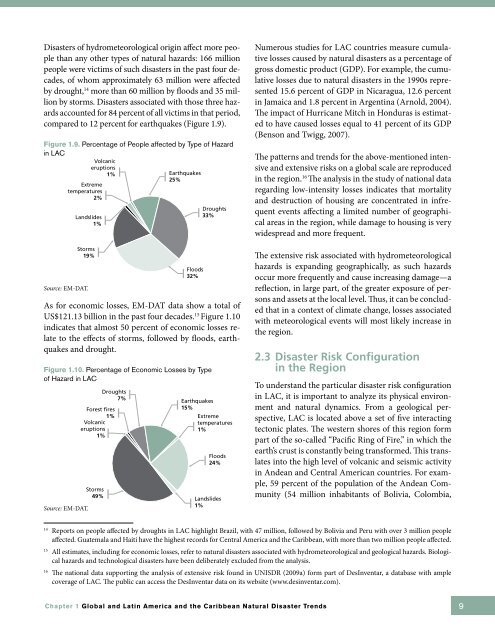Preventive Resettlement of Populations at Risk of Disaster - GFDRR
Preventive Resettlement of Populations at Risk of Disaster - GFDRR
Preventive Resettlement of Populations at Risk of Disaster - GFDRR
Create successful ePaper yourself
Turn your PDF publications into a flip-book with our unique Google optimized e-Paper software.
<strong>Disaster</strong>s <strong>of</strong> hydrometeorological origin affect more people<br />
than any other types <strong>of</strong> n<strong>at</strong>ural hazards: 166 million<br />
people were victims <strong>of</strong> such disasters in the past four decades,<br />
<strong>of</strong> whom approxim<strong>at</strong>ely 63 million were affected<br />
by drought, 14 more than 60 million by floods and 35 million<br />
by storms. <strong>Disaster</strong>s associ<strong>at</strong>ed with those three hazards<br />
accounted for 84 percent <strong>of</strong> all victims in th<strong>at</strong> period,<br />
compared to 12 percent for earthquakes (Figure 1.9).<br />
Figure 1.9. Percentage <strong>of</strong> People affected by Type <strong>of</strong> Hazard<br />
in LAC<br />
Source: EM-DAT.<br />
As for economic losses, EM-DAT d<strong>at</strong>a show a total <strong>of</strong><br />
US$121.13 billion in the past four decades. 15 Figure 1.10<br />
indic<strong>at</strong>es th<strong>at</strong> almost 50 percent <strong>of</strong> economic losses rel<strong>at</strong>e<br />
to the effects <strong>of</strong> storms, followed by floods, earthquakes<br />
and drought.<br />
Figure 1.10. Percentage <strong>of</strong> Economic Losses by Type<br />
<strong>of</strong> Hazard in LAC<br />
Source: EM-DAT.<br />
Landslides<br />
1%<br />
Storms<br />
19%<br />
Volcanic<br />
eruptions<br />
1%<br />
Extreme<br />
temper<strong>at</strong>ures<br />
2%<br />
Droughts<br />
7%<br />
Forest fires<br />
1%<br />
Volcanic<br />
eruptions<br />
1%<br />
Storms<br />
49%<br />
Earthquakes<br />
25%<br />
Floods<br />
32%<br />
Droughts<br />
33%<br />
Earthquakes<br />
15%<br />
Extreme<br />
temper<strong>at</strong>ures<br />
1%<br />
Floods<br />
24%<br />
Landslides<br />
1%<br />
Numerous studies for LAC countries measure cumul<strong>at</strong>ive<br />
losses caused by n<strong>at</strong>ural disasters as a percentage <strong>of</strong><br />
gross domestic product (GDP). For example, the cumul<strong>at</strong>ive<br />
losses due to n<strong>at</strong>ural disasters in the 1990s represented<br />
15.6 percent <strong>of</strong> GDP in Nicaragua, 12.6 percent<br />
in Jamaica and 1.8 percent in Argentina (Arnold, 2004).<br />
The impact <strong>of</strong> Hurricane Mitch in Honduras is estim<strong>at</strong>ed<br />
to have caused losses equal to 41 percent <strong>of</strong> its GDP<br />
(Benson and Twigg, 2007).<br />
The p<strong>at</strong>terns and trends for the above-mentioned intensive<br />
and extensive risks on a global scale are reproduced<br />
in the region. 16 The analysis in the study <strong>of</strong> n<strong>at</strong>ional d<strong>at</strong>a<br />
regarding low-intensity losses indic<strong>at</strong>es th<strong>at</strong> mortality<br />
and destruction <strong>of</strong> housing are concentr<strong>at</strong>ed in infrequent<br />
events affecting a limited number <strong>of</strong> geographical<br />
areas in the region, while damage to housing is very<br />
widespread and more frequent.<br />
The extensive risk associ<strong>at</strong>ed with hydrometeorological<br />
hazards is expanding geographically, as such hazards<br />
occur more frequently and cause increasing damage—a<br />
reflection, in large part, <strong>of</strong> the gre<strong>at</strong>er exposure <strong>of</strong> persons<br />
and assets <strong>at</strong> the local level. Thus, it can be concluded<br />
th<strong>at</strong> in a context <strong>of</strong> clim<strong>at</strong>e change, losses associ<strong>at</strong>ed<br />
with meteorological events will most likely increase in<br />
the region.<br />
2.3 <strong>Disaster</strong> <strong>Risk</strong> Configur<strong>at</strong>ion<br />
in the Region<br />
To understand the particular disaster risk configur<strong>at</strong>ion<br />
in LAC, it is important to analyze its physical environment<br />
and n<strong>at</strong>ural dynamics. From a geological perspective,<br />
LAC is loc<strong>at</strong>ed above a set <strong>of</strong> five interacting<br />
tectonic pl<strong>at</strong>es. The western shores <strong>of</strong> this region form<br />
part <strong>of</strong> the so-called “Pacific Ring <strong>of</strong> Fire,” in which the<br />
earth’s crust is constantly being transformed. This transl<strong>at</strong>es<br />
into the high level <strong>of</strong> volcanic and seismic activity<br />
in Andean and Central American countries. For example,<br />
59 percent <strong>of</strong> the popul<strong>at</strong>ion <strong>of</strong> the Andean Community<br />
(54 million inhabitants <strong>of</strong> Bolivia, Colombia,<br />
14<br />
Reports on people affected by droughts in LAC highlight Brazil, with 47 million, followed by Bolivia and Peru with over 3 million people<br />
affected. Gu<strong>at</strong>emala and Haiti have the highest records for Central America and the Caribbean, with more than two million people affected.<br />
15<br />
All estim<strong>at</strong>es, including for economic losses, refer to n<strong>at</strong>ural disasters associ<strong>at</strong>ed with hydrometeorological and geological hazards. Biological<br />
hazards and technological disasters have been deliber<strong>at</strong>ely excluded from the analysis.<br />
16<br />
The n<strong>at</strong>ional d<strong>at</strong>a supporting the analysis <strong>of</strong> extensive risk found in UNISDR (2009a) form part <strong>of</strong> DesInventar, a d<strong>at</strong>abase with ample<br />
coverage <strong>of</strong> LAC. The public can access the DesInventar d<strong>at</strong>a on its website (www.desinventar.com).<br />
Chapter 1 Global and L<strong>at</strong>in America and the Caribbean N<strong>at</strong>ural <strong>Disaster</strong> Trends 9
















